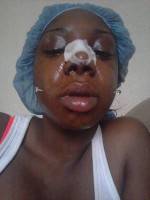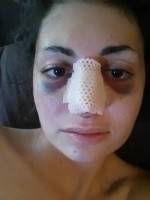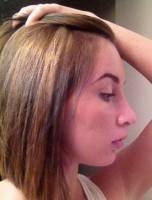Rhinoplasty To Improve Breathing
Breathing after Rhinoplasty
After rhinoplasty, changes in the dynamics of air flow through the nose are very common. A successful rhinoplasty should leave the nose looking balanced, and breathing better.
Complications responsible for breathing problems after rhinoplasty are as follows: Nasal valve collapse – a narrowing of the cartilage-containing portion of the bridge.
This complication can have both functional and cosmetic consequences. The area where the side cartilages (upper lateral) meet with the septum along the midline of the lower portion of the bridge may cause a narrowing that is worse on deep inspiration.
This can be corrected with spreader grafts, but is best avoided with spreader grafts, or a flap of the upper lateral cartilages (ask your doctor to explain this during the consultation if he/she beleives it may be necessary).
Deviation or re-deviation – a very common cause for nasal obstruction is deviated nasal septum. The septum (wall in between the two sides of the nose) is commonly noted to be deviated in many people.
This deviation may not be symptomatic, but in the setting of an altered nasal airway after reduction or occasionally over-reduction of the bridge, the deviation may cause nasal obstruction on one or both sides.
Moderate or severe deviations should be addressed during surgery to help avoid breathing problems. Inferior turbinates – these are normal tissues responsible for congestion of the nose during colds, allergies, weather changes, or even crying.
The inferior turbinates should be somehow addressed during almost all rhinoplasties. Current standard of care for the inferior turbinates involves conservative reduction methods that preserve the mucus membrane, but shrink the overall size of the turbinates to releive any nasal obstruction that may be symptomatic after surgery.
Some patients with breathing problems after rhinoplasty may benefit from an office procedure to shrink the mucus membrane of the inferior turbinates to improve the nasal airway.
As a component of the nasal valve (see above) turbinate reduction may also releive some symptoms associated with the narrowing of the valve area.
This procedure is an integral part of almost all of my rhinoplasties. Internal nasal scarring (synechiae)- some operations result in inadvertant (in some cases possibly careless) abrasions or scratches of the mucus membrane inside of the nose.
The septum (middle wall) and the outer walls may have opposing scratches that heal together, and effectively close or narrow the nasal cavity.
Correction involves releasing or removing the scars, and placing splints inside the nose for one to two weeks to prevent recurrence.
Over-resection – aggressive removal of cartilage and bone can lead to weakening of any part of the nose. The external valve (nostril openings) may also be weakened by aggressive reduction of the skeletal components of the nose and also collapse or close during inspiriation – especially during exertion. Perforation of the nasal septum – a dreaded complication of surgery, a perforation of hole in the septum of the nose may cause nasal obstruction by altering the dynamics of airflow through the nose, crusting, scarring, even frequent bleeding and blood clots. Experienced surgeons have fewer reported complications such as this, and should also be well versed in techniques to prevent, and repair perforation of the nasal septum.
These are topics which you should feel comfortable discussing with your surgeon. An experienced rhinoplasty surgeon may even discuss these with you during your consultation, and should always ask directed questions regarding your nasal health and breathing. A thourough examination of the nasal cavity should also be preformed during a consultation to plan for prevantative measures during your rhinoplasty surgery. (Behrooz Torkian, MD, Beverly Hills Facial Plastic Surgeon)
Rhinoplasty should improve nasal breathing
It is unusual to have breathing problems following rhinoplasty when the more sophisticated and advanced techniques are used. We saw a lot of breathing problems following the old style of rhinoplasty but in 2010 our techniques are designed to improve the breathing at the same time as improving the cosmetic appearance of your nose. (Jason B. Diamond, MD, Beverly Hills Facial Plastic Surgeon)
Rhinoplasty and breathing
Breathing problems after a cosmetic rhinoplasty should not typically occur. In the immediate recovery period there may be packing in the nose, blood or mucous buildup, and swelling which will definitely impact breathing. However, as the nose heals and swelling improves, breathing should return to preoperative levels. Prior to undergoing any nose surgery, a careful examination of the function of the nose is imperative. You surgeon should check for evidence of breathing obstruction or potential for breathing complications. For instance, in some patients with large bumps on the nose care must be taken when reducing the bump. This may lead to breathing obstruction. However, if recognized prior to surgery, your surgeon may suggest cartilage grafts to open up these areas to prevent the obstruction. (David Bogue, MD, Boca Raton Plastic Surgeon)
Breathing problem after rhinoplasty is a complication.
Hi. The results of rhinoplasty vary a lot, depending on the surgeon. In New York City, we consider breathing problems after a nose job to be a rare and usually avoidable complication. In good hands, you should not have breathing problems. (George J. Beraka, MD (retired), Manhattan Plastic Surgeon)
Difficulty Breathing After Rhinoplasty Chicago
It is not uncommon to have some difficulty breathing through your nose right after surgery. The areas are traumatized and swollen, and because of this, it can take a few weeks for patients to feel like they are breathing normally again. However, there are some patients who are at risk for having long term airway obstructions after rhinoplasty.
If you narrow the nose too much without placing certain grafts, or alter the natural cartilage framework too much, then there is an increased risk of airway obstruction after surgery. The goal is to identify these patients beforehand and make sure the appropriate steps are taken to minimize such complications. (Christopher V. Pelletiere, MD, Barrington Plastic Surgeon)
Rhinoplasty should not cause breathing problems
It is important to evaluate the nasal function in addition to the appearance. A successful rhinoplasty should correct the deformity in question as well as maintain the preoperative breathing.
If nasal obstruction is present preoperatively, this should also be corrected at the time of surgery. A good rhinoplasty surgeon will understand the structure and physiology of the nose and be able to tailor each surgery to achieve the best cosmetic AND functional results.
It is not unusual to have temporary obstruction after surgery due to swelling but if you have no problems breathing before surgery then it is unlikely you’ll have problems afterwards. (Corey S. Maas, MD, San Francisco Facial Plastic Surgeon)
Rhinoplasty: how to avoid post-op breathing problems
A well-trained rhinoplasty surgeon should always examine the nose functionally to make sure that any cosmetic adjustments do not interfere with breathing. When I evaluate a patient’s nose, I look at the septum and turbinates internally. I check to see how long the nasal bones are.
I evaluate the openings to the nose to see that they are well-supported on inspiration. Any areas of collapse are noted and corrections made during surgery. I always try to leave the nose better that I found it. Make sure your surgeon does the same. (Manish H. Shah, MD, FACS, Denver Plastic Surgeon)
Yes and No – you may have breathing problems
Immediately after rhinoplasty, packing (in some cases), swelling, and mucous/bloody fluid will definitely make you feel like there is a clothespin on your nose.
After a week or two, as the swelling resolves, the great majority of patients can breathe as well or even better than they did before the surgery. Many surgeons ignore the nasal septum when performing cosmetic rhinoplasty.
When the nose is reduced, it is essential that the septum is also reduced. If not, a previously straight and non-problematic nasal septum will buckle and deviate, causing breathing problems. If the nasal septum is deviated to begin with, then it must be corrected.
The only time that the septum can be left alone is if the nose is not to be reduced, and if it is relatively straight to begin with.
Another cause of post-op breathing problems is when too much lower lateral nasal cartilage is removed in the attempt to reshape the tip of the nose. Lastly, the lateral internal walls of the nose have structures called inferior turbinates.
They can be reduced permanently in a non-invasive in-office 15 minute procedure called Somnoplasty. Please remember to choose your rhinoplastic surgeon most carefully to avoid these and other problems. (Michael A. Persky, MD, Encino Facial Plastic Surgeon)
Rhinoplasty swelling may make breathing difficult
Breathing problems should be one of the main parts of a preoperative exam prior to rhinoplasty. If indicated, the breathing obstruction should be treated during the surgery.
In the immediate postoperative period with rhinoplasty, there will be some swelling that may make breathing difficult with the dressings. Patients are often advised to breathe through their mouths for the first few days. (Raffy Karamanoukian, MD, FACS, Los Angeles Plastic Surgeon)
Balancing Functional Operation and Cosmetic Improvement
Rhinoplasty should be performed to ensure functional operation while achieving cosmetic improvement.
Postoperative swelling may lead to nasal congestion, but the surgeon should and an expert and experienced does account for the swelling.
Consult with 3 – 4 expert and experienced board certified plastic surgeons to understand your options. (Kris M. Reddy, MD, FACS, West Palm Beach Plastic Surgeon)
Temporary nasal stuffiness after rhinoplasty is the rule; permanent obstruction is rare
While almost all patients experience severe stuffiness the first week after rhinoplasty, almost all have full resolution over the next few weeks. (Laxmeesh Mike Nayak, MD, Saint Louis Facial Plastic Surgeon)
Does rhinoplasty cause breathing problems?
Rhinoplasty shouldn’t cause difficulty with nasal breathing. While Septoplasty and Turbinate surgery are the procedures to improve nasal breathing, Rhinoplasty is occassionally also required.
More commonly Rhinoplasty is performed for cosmetic reasons, and the nose is often narrowed which can occassionally result in reduced nasal breathing. It’s an uncommon complication, likely occurring about 1% of the time. (Oakley Smith, MD, Toronto Facial Plastic Surgeon)
Can Rhinoplasty surgery cause trouble breathing afterwards?
Rhinoplasty surgery typically does not cause trouble breathing afterwards if performed correctly. There can be temporary breathing difficulty following rhinoplasty surgery due to post-operative swelling but this should resolve with time. (Robert Heck, MD, Columbus Plastic Surgeon)
Providing a good airway after surgery on the nose is essential.
Maintaining good breathing after rhinoplasty is a concern. Surgeons skilled in rhinoplasty will take special caution in how they approach each procedure to make sure they maintain a good airway and, thus, good breathing. Most times during rhinoplasty breathing problems if anything can be improved. As a matter of fact, septoplasty which straightens the internal wall of the nose provides better breathing and can be done at the same time as rhinoplasty.
In addition, insurance will often cover a septoplasty if a patient is having persistent breathing problems beforehand. Maintaining good breathing is definitely a concern with rhinoplasty. Discussing this with your facial plastic or plastic surgeon beforehand is important. Experienced rhinoplasty surgeons will welcome your concern and use techniques to improve or maintain your airway and your breathing. (Mark Hamilton, MD, Indianapolis Facial Plastic Surgeon)
Rhinoplasty and breathing
Rhinoplasty is commonly performed for both cosmetic and functional (breathing) purposes. When being performed for cosmetic purposes only, a surgeon must maintain or improve the nasal airway and prevent collapse or worsened breathing. A beautiful nose is not very helpful if it does not function effectively. (Etai Funk, MD, Houston Facial Plastic Surgeon)
Breathing Problems After Rhinoplasty
It is not uncommon after both functional and/or cosmetic rhinoplasty to have temporary breathing problems. That is primarily due to internal swelling after a cosmetic rhinoplasty only and will usually subside in 1-2 weeks. If it has been from a functional rhinoplasty where the septum was straightened, it may take 4-6 weeks for the airway breathing to improve. The important thing to maintain your nasal airway is to use nasal saline irrigations to help clear your airway during the time when it is maximally swollen to allow for normal wound healing. (Rod J. Rohrich, MD, Dallas Plastic Surgeon)
Rhinoplasty and Breathing
You should NOT have breathing problems as a results of rhinoplasty surgery. If anything rhinoplasty surgery should actually improve your breathing. Older rhinoplasty techniques resulted in some breathing problems, but modern, advanced techniques should not alter and even improve your ability to breath through your nose. It is important to see a highly skilled rhinoplasty surgeon who examines your nose inside and outside thoroughly prior to surgery. This assures the best possible results.
Seek out a facial plastic surgeon or plastic surgeon that specializes in noses, and addresses both the functional (breathing) and the cosmetic concerns that you have. (Jacob D. Steiger, MD, Boca Raton Facial Plastic Surgeon)



